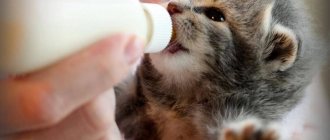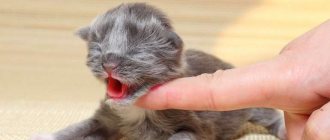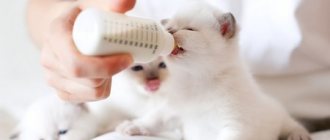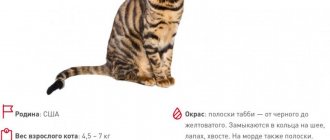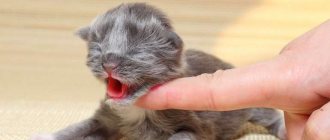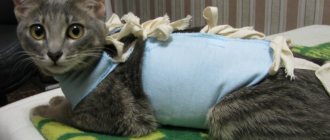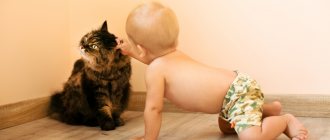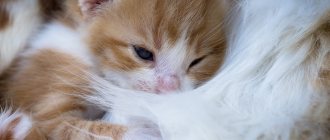There are rules for feeding three-week-old kittens without a mother; they are not universal and do not guarantee anything, but they significantly increase the chances of survival of the babies. Feeding a three-week-old kitten is difficult! These are sleepless nights, heating pads, colic, everything is almost the same as with children. If you become the parent of an orphaned baby, purchase everything you need as quickly as possible and learn feeding methods!
It is important to immediately develop a proper feeding regimen, this will relieve the kitten from tummy pain. The next step is choosing between milk replacers and formula. We will look into how to choose the right vitamins and supplements and when to introduce the first complementary foods below.
When do kittens need artificial feeding?
The ideal situation is as follows: the cat cares for and feeds the kitten until it is approximately 8 weeks old. Only then can you separate the baby from his mother. But there are times when human intervention and help is required. Reasons why this may happen include:
- death of a cat;
- lack or deficiency of milk in her;
- mastitis and inflammation of the uterus in a cat;
- eclampsia in a cat, that is, calcium deficiency;
- psycho-emotional deviations of the animal.
Sometimes the mother feeds the kittens regularly, but the babies still need complementary foods. This situation may arise if the litter is very large. It happens that a weak kitten is born, which quickly gets tired when sucking - in this case, it also needs additional nutrition. How you manage to feed a kitten without a cat or simply intervene a little in the process will determine its future health.
Why does a cat abandon kittens?
Despite the fact that pets are considered caring and attentive, due to a number of factors the natural mechanism of maternal care can fail. There may be several reasons why a cat refuses kittens:
| Cause | Justification for the action |
| Young age of the animal, first birth | An inexperienced mother does not immediately demonstrate the instincts of motherhood inherent in nature. As a rule, on the second day after birth, the animal accepts the kittens and takes proper care of them. |
| Postpartum complications | Diseases such as mastitis (inflammation of the mammary glands), endometritis (inflammation of the lining of the uterus) and simply difficult childbirth are accompanied by pain, physical and psychological stress. With postpartum eclampsia (severe lack of calcium in the body), a disorder occurs in the cat’s nervous system (postpartum insanity), and she abandons the babies |
| Stressful situation | Excessive attention to the animal during childbirth, interference in the intimate process can cause severe stress in the cat, against the background of which it abandons its offspring |
| Foreign odors from kittens | A cat may abandon her babies if they don't smell like her. This often happens if household members hold babies in their arms, and they stop smelling like their mother. This behavior is especially dangerous towards newborns who have not yet smelled their mother cat. |
| Lack of milk in the first days after birth | The reason why a cat abandons newborn kittens may be the lack of lactation due to hormonal imbalance immediately after lambing. |
| Non-viability of babies | The cat instinctively identifies the sick cub and abandons it, giving others a chance to survive. The same fate awaits a hypothermic kitten (with a low body temperature), which is also an indicator of non-viability for the mother |
| Weak maternal instinct | Most often this happens to spoiled pets who do not bother themselves with caring for their offspring, completely shifting the entire burden of this process onto the owner |
Cat milk replacers
If the circumstances are not the best and the kitten is left without a mother, the ideal option would be to find a wet-nurse cat. If this is not possible, some alternative to cat milk will come to the rescue - its substitute. Feeding a newborn kitten is not as difficult as it seems at first glance.
Special mixtures from veterinary pharmacy
There are no organic substitutes for cat milk in nature. But today, some pet food manufacturers have created special mixtures - artificial substitutes for cat milk. They are as close as possible to the natural composition and are optimally balanced for kittens. The mixtures include many components useful for the growth and development of small pets:
- vitamins;
- minerals;
- microelements;
- Omega-3 and Omega-6 fatty acids;
- taurine
The veterinary formula is ideal for raising kittens until they are able to eat solid food on their own.
Recipes for DIY mixtures
If the price of a special mixture is too high or it is not sold in your locality, you can make it yourself - several recipes are offered.
Milk and flour
You will need 250 grams of condensed milk: always natural and twenty percent. You need to dilute it with a liter of water and add about a teaspoon of bone meal. Strain, heat and feed to babies. The mixture can be stored for no more than a day, so it is recommended to prepare it in smaller quantities. The main thing is to maintain the proportion 1:4.
With goat milk
A tablespoon of five percent glucose is mixed with goat milk, of which you will need about 1.5 tablespoons. Next, you need to add one gram of various vitamins (purchased at a veterinary pharmacy) and a teaspoon of milk powder.
Vitamin
Five percent glucose is mixed with one hundred milliliters of milk and an yolk mixed with half a tablespoon of vegetable oil is added. In the mixture you need to add Nutrilon milk baby food and a few drops of Tetravit.
Egg
A teaspoon of vegetable oil is mixed with the yolk and drops of vitamins in a proportion similar to the previous recipe.
Regardless of the composition, it is necessary to keep cat formulas in the refrigerator, and when serving, heat them to a temperature of 37 ° C. Veterinarians advise preparing complementary foods more often so that they are always fresh.
Why you shouldn't give cow's milk
When asked whether it is possible to feed a newborn kitten with cow's milk, veterinarians answer unequivocally in the negative. The composition of cat milk is very different from the milk of other animals - the amount of fat, protein and lactose varies greatly. Even adult cats do not digest goat's and cow's milk well, with their high content of lactose and fat, let alone kittens.
If you ignore the advice of veterinarians and scientifically proven facts, you can harm the baby’s health. Allergies, diarrhea, lack of essential nutrients, developmental delays - this is not a complete list of problems that can arise in a small animal when fed cow's milk. Take care of your baby's health and use special mixtures.
Making your own kitten formulas
You can prepare milk formulas for small kittens aged 2 weeks to a month yourself using simple recipes:
- Tailing's mixture is nutritious and will be especially useful for exhausted, weakened, and poorly gaining weight babies. To prepare the mixture, add 5 g of milk powder, cat vitamins (1 g), and glucose (4 g) to 25 g of homemade milk. All ingredients are thoroughly mixed until smooth, without lumps, and heated over low heat to +38°C. The finished mixture is cooled to room temperature and used to feed artificial kittens through a pacifier or pipette.
- Scott's formula is a complete nutrition for kittens that can even replace mother's milk. To prepare this recipe, you need to combine the ingredients in one container: cow's milk (50 g), yeast (3 g), milk powder (15 g), sugar (5 g), sunflower oil (1 g), whipped egg white (50 g) , egg yolk (1). The mixture is whipped until smooth and heated to +37°C with constant stirring. The finished composition is poured into a bottle and cooled to room temperature. The mixture can be stored in the refrigerator, but no more than 1 day.
How to feed a small kitten: features and rules
There are certain rules and nuances of feeding a kitten. This applies to both the feeding regimen and procedures after it.
What things will you need?
To feed a kitten, you will have to purchase some items. A bottle with a special nipple will be more convenient for you and better for the animal: such a thing is sold in a veterinary pharmacy. It has an anatomically correct shape and resembles a cat's nipples.
You can feed newborn kittens without a cat either with a pipette or with a syringe without a needle. But this option is undesirable, since during feeding, air may enter the esophagus or milk may enter the respiratory tract, causing the animal to choke or regurgitate. It is very important to wash and sterilize items after each feeding.
Stages of the procedure
When everything you need has been collected and sterilized, dilute the mixture according to the instructions and heat it. It is not recommended to do this in the microwave - the mixture may warm up unevenly - it is better to heat it in a water bath.
Check your pet's body temperature. If the paws are cold, the kitten is cold, which means the food will be digested much worse. The baby must be kept warm at all times. To do this, place a heating pad wrapped in a towel or a bottle of hot water in his box or house.
When you are sure that the kitten is warm, you can proceed directly to the feeding process. To do this, lay a towel on your knees, carefully lay the kitten on its stomach and lift its head a little - this is the position in which kittens feed from their mother. For the very first time, you should moisten the nipple's spout with milk so that the baby smells the food and begins to eat.
How to determine if a kitten is full
Both conditions are extremely undesirable and even dangerous for a baby: underfeeding and overfeeding. If he doesn't get enough food, he doesn't gain weight well and appears lethargic. Overeating is indicated by loose stools in yellow, green and gray shades. You can visually determine whether the kitten is full in the following way: extend your finger to it. If the animal begins to suck, then it is not full.
The baby’s behavior is also an indicator. If the kitten is full, he simply turns away and falls asleep, sometimes milk bubbles come out of his mouth, if not, he squeaks, crawls and looks for a pacifier.
What to do after feeding
During the process, try your best to ensure that the animals are calmed by your voice. Talk to them and be sure to pet them, and after feeding, wipe off any remaining food from their faces.
At the end of feeding, lightly press the kitten's back against your stomach and gently stroke its tummy. With these actions you stimulate belching and start the process of digesting food.
To prevent kittens from suffering from constipation, it is necessary to massage their anus. This is done with cotton pads or ear swabs, which are dipped in Vaseline.
Artificial stimulation of peristalsis does not always help, and babies experience stool retention. In this case, you need to give an enema, but it is better to do this under the supervision of a veterinarian - leave the procedure to him for the first time, later you will learn how to give enemas to kittens yourself.
How to help an animal
If the cat has stopped feeding the kittens due to excessive anxiety or stress, it is necessary to provide her with complete rest. During lambing, you should observe and interfere with the process only if absolutely necessary. Additionally, there are the following restrictions:
- Under no circumstances should you touch newborn kittens.
- You cannot handle the babies, pick them up, or constantly look into the nest, especially in the first 2 weeks of the babies’ lives.
- The place where the cat is with its offspring should be secluded, quiet, warm and dark. Solitude and complete peace will calm the mother, and she will accept her cubs.
In a situation where a cat has abandoned newborn kittens, the owner first needs to seek help from a veterinarian:
- If the cause of this behavior was a postpartum complication or hormonal imbalance, then the problem can be solved by applying adequate treatment to the animal. So, for postpartum eclampsia, calcium supplements are prescribed to the cat.
- For mastitis and endometritis – antibacterial therapy.
- In case of hormonal imbalance, special drugs are used to normalize the endocrine system.
If a cat has stopped feeding kittens due to a poorly developed maternal instinct, you can try to help her. To do this, you need to calm the animal, caress it, and lay it on its side. Slowly place one kitten at a time, without ceasing to praise and stroke the mother. You can drop the mother’s favorite treat on the babies’ forehead, she will start licking it, and this will start the mechanism of caring for the offspring.
How often should you feed
It is imperative to follow the regime and monitor the portions of the mixture. For the first two weeks, you will have to feed the kitten every 2 hours, even at night. Then the intervals are gradually shortened. After five weeks, the kitten can easily survive without food for 3-4 hours, and at night one feeding is enough for him.
At 6 weeks of age, babies feed on their own: they need to be fed up to 5 times a day and only during the daytime. Kittens grow very quickly, so the nursing period will not seem very long.
Calculation of daily portions
In the natural environment, a cat does not control the amount of milk her kittens eat. But since the task is to feed a kitten without a cat, certain standards must be observed. The baby quickly gains weight, but his stomach volume is very small, so feeding should be dosed. The daily intake of the mixture depends on the age of the baby. Below is the amount calculated per 100 g of animal body weight:
- from birth to day 5 – 30 ml;
- from 6 to 14 days – 38 ml;
- from 15 to 24 days – 45 ml;
- from the 25th day and over the next month - 55 ml.
These are recommended figures and may vary slightly for each breed. The daily volume must be divided by the number of feedings. The most preferable option, as for humans, is in small portions, but more often.
Difficulties and errors
The main and most serious mistake is a frivolous attitude towards what and in what quantities you feed the kitten. This can lead to serious problems with his health.
Pay attention to the position in which the baby eats. If you place it on its back, the mixture may enter the lungs while eating, and this often leads to death. It happens that milk comes out of the nose and the stomach swells greatly - this means that the baby has swallowed a lot of air and is trying to burp. During feeding, be sure to ensure the correct position.
If it is still acceptable to feed a kitten with a syringe at the initial stage, then experts do not recommend doing it from a spoon - such actions can lead to the fact that the sucking reflex disappears, and the baby will not be able to eat normally in the future.
What to feed a kitten at 3 weeks?
The fact is that the baby does not tolerate regular cow's milk well, since it has a different taste than cat's milk, and also contains 10 times less protein. Milk substitute, which can be purchased at a pet store, gives good results. If the kitten does not want milk, you can try giving him infant formula, which is specially adapted to the needs of the growing body.
The most universal recipe: mix 0.5 liters of concentrated milk, 4 teaspoons of sugar and egg yolk.
For a 3-week-old kitten, you can start giving a little finely chopped beef, fish, and low-fat cottage cheese. Keep an eye on your baby's stool. If it is liquid, then the milk can be diluted with water to reduce the concentration of lactic acids in the mixture.
Caring for newborn and older kittens
To create comfortable conditions for furry babies, you need to take care of their place of residence. A large basin or cardboard box will serve as a “dwelling”, but you will have to constantly ensure that it does not get wet. For this purpose, absorbent material is purchased that absorbs excess moisture.
In the first days of life, kittens especially need warmth, so it is advisable to install a heater near their place of residence. If you don't have one, use a heating pad wrapped in a towel or a hot water bottle. Don’t forget: the minimum ambient temperature in the first two weeks of a baby’s life is kept at 30° C. After 14 days, lower the temperature to 24° and do not change it for another three weeks.
At three weeks of age, babies begin to try to walk: be careful that they do not fall out of their nest and get injured. The first walks should take place under your watchful supervision.
Try not to let kittens onto the carpet: they do not yet know how to retract their claws and therefore constantly cling. In worst cases, the baby may be injured.
At the fifth week of life, kittens see well and move actively. Then they are introduced to the first complementary foods. By 6 weeks of age they can eat solid food, and at 8-10 weeks they can be given to new owners.
To monitor the development of kittens, you will need an accurate scale. Weighing babies is necessary for:
- calculating the volume of daily portions;
- tracking growth rates.
If your kitten is not gaining weight well, you should consult your veterinarian. Perhaps the baby is malnourished or sick with something.
